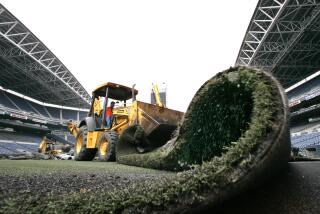Fake Trees Among Reasons for Staying in Cell Dead Zone
It was annoying at first. Iâd get close to home and my cell phone signal would start to die, the person on the other end going, going, going, gone.
Can you believe it? I carped to my wife. Weâre living in the city of the future, a modern metropolis like none before it, and itâs still the Stone Age in Silver Lake.
Then it hit me one day. Living in the bottom of a bowl, with hills rising all around to block phone signals, has certain advantages.
The boss couldnât track me down. I couldnât indulge a compulsive need to check messages every minute of the day. In stores and restaurants, I saw very few self-important twits yapping into the latest designer cell phone.
In a world where people canât seem to be alone with themselves for two minutes, untethered and unaccounted for, it was bliss. And I knew, of course, that it probably wouldnât last.
I began seeing notices posted around the neighborhood. Various efforts were underway to erect cellular antennas so Silver Lake could come in from the cold and join the rest of the civilized world.
This was not a story about cell phones, I realized, but about conformity through merchandising and fear-mongering. Man seemed to do just fine for centuries without phones of any kind, but now wireless companies were warning of catastrophic dangers in a cell phone dead zone, such as lost productivity, or worse.
What would we do if, God forbid, we had an emergency?
I donât know. Knock on someoneâs door and ask to use the phone?
One antenna plan in particular caught my eye. Cingular would like to build a tower not far from my house, on public property near the lake. The tower would be camouflaged as a plastic pine tree.
I have nothing against artificial plants, per se. But this one would soar above the existing tree line and rise to twice the commercial height limit, like some giant silicon sequoia.
âThey call it a monopine,â says Maryann Kuk, who is not fond of the idea. She fears that if you say yes to one fake tree, there could soon be a plastic forest.
As for why itâs called a monopine, Kuk wasnât sure. I kind of like robopine.
âIâd like to see a hawk land in it,â says Marilyn Oliver. âThat would be interesting.â
My boss, who happens to be a neighbor, doesnât understand the fuss.
âItâs a fake lake,â says the city editor, referring to the fenced-in reservoir. âWhatâs wrong with a fake tree next to a fake lake in a neighborhood where youâve got fake people in their 40s wearing all black to go to the 7-Eleven?â
This is the kind of question I have to put up with on every column. Maybe now you can see why I donât want the office to be able to reach me by cell phone.
Cingular offered $110,000 for sidewalk improvements on the pathway around the lake, but residents refused to be bought off. At a recent meeting, they gave it a thumbs-down, 5 to 1. They also went to the site and raised helium-filled balloons to a height of 75 feet, so everyone could see exactly where this beanstalk would pierce the ozone layer.
I think if Cingular had offered free yoga classes, Converse high-tops and sacks of Trader Joeâs French roast to every man, woman and partner in Silver Lake, it might have made some headway. It might even have worked if theyâd called the tree postmodern art, but they donât understand our neighborhood.
Instead, the wireless company blundered into handing out samples of fake bark, thinking that would quell the revolution.
âThere it is,â said Harvey Steinberg. A patch of bark was laid out on a table in his house.
It actually looks pretty real, doesnât it? he asked.
I suspect no dog would be fooled, but yeah, it looks real in the way fake vomit looked real in junior high.
Thatâs not the point, though, as USC professor and Silver Lake resident Ralph Knowles wrote in opposition. Blue herons, mallards, coyotes, Canada geese and other animals can be seen around the lake, he noted.
âIntroducing fake trees,â he wrote, âno matter that they are dyed green and have molded bark trunks, cannot really fool the eye or the spirit.â
Thank you, professor.
Last week at City Hall, a zoning administrator looked out at a roomful of Silver Lake rabble rousers and ruled against Cingular, but the company might appeal.
I called Cingular and havenât heard back. Of course, the call might have been patched through to my cell phone, and Iâm in the dead zone, untethered, disconnected, a free man in the natural world.
*
Steve Lopez writes Sunday, Wednesday and Friday. He can be reached at steve.lopez @latimes.com.







